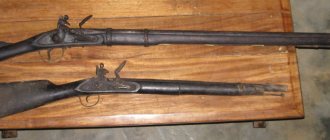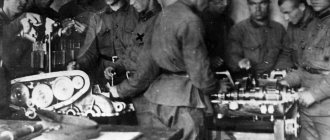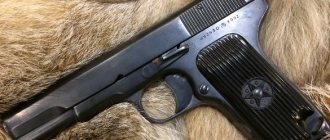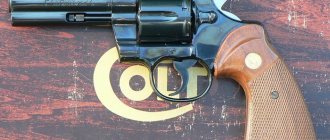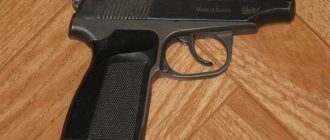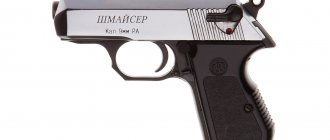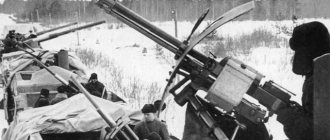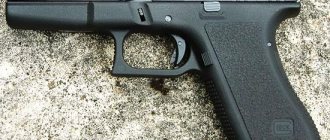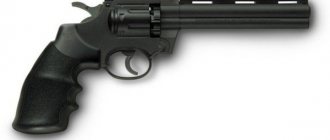Smith & Wesson - an American legend
First generation Smith & Wesson pistols
9 mm pistols Smith&Wesson V 39/59
The world-famous Smith & Wesson company was founded a century and a half ago, in 1852, by two American gunsmiths Horace Smith and Daniel B. Wesson in Norwich (Connecticut). Since then, for most people, the name of this one of the most famous American arms companies has been invariably associated with revolvers of the same name. And this is true; until the middle of the last century this was true.
9-mm Smith & Wesson M 39 pistol
During the Second World War alone, Smith & Wesson produced more than one million Smith & Wesson .38 Military & Police model revolvers for the American and British armies. And only after 1945 this company returned to the production of civilian weapons, including self-loading pistols.
In 1948, the high command of the US armed forces tried to replace the outdated .45 Colt M1911 A1 pistol that was in service with a new, more modern weapon. For this purpose, a special competition was organized, which included comprehensive testing of the proposed samples. In 1949, specifically for these purposes, on the initiative of the executive director of Smith & Wesson, K. Hellstrom, all weapons production was moved in Springfield to new, more spacious buildings. Smith & Wesson, whose management had long dreamed of receiving a large military order, had already created prototypes of a self-loading pistol with a single-action trigger mechanism. This weapon was tested along with samples from other companies at the Springfield Armory military plant, which at that time belonged to the state. However, the tests, which began with great fanfare, were not even completed, as the Pentagon suddenly changed its mind, deciding to retain the Colt M 1911 A1 pistols as the service weapon of US Army units. However, less than five years had passed before, in 1953, they again started talking about replacing the Colt pistol. And again, like last time, Smith & Wesson had a prototype of a pistol with a double-action trigger mechanism, borrowed from the German “Walter” R.38. It was developed by the company's leading designer Joseph Norman and became the first pistol in the United States with a self-cocking (for the first shot) trigger mechanism. The new pistol, designed to use the 9x19 Parabellum pistol cartridge, made a good impression on the specialists.
Smith&Wesson M 39-2 9mm pistol
Colt, the main competitor of Smith & Wesson in the fight for lucrative army orders, was also not asleep, having developed the Colt pistol (Commander model) specifically for the army. However, just like last time, the tests that had already begun were canceled again.
The Colt M 1911A1 pistol remained in service in the United States, and Smith & Wesson, in turn, tried to conquer the civilian market with its new products (in fact, it simply had nothing else to do). In 1958, it offered pistols of two models at once - M 39, with a self-cocking trigger mechanism (double action) and its variant - M 44, with a single action trigger mechanism. This is how the first generation Smith & Wesson pistols appeared.
The operating principle of the automatic pistol M 39 is the use of recoil energy with a short barrel stroke. The coupling of the barrel to the bolt was carried out by one protrusion on the upper surface of the barrel through a groove on the inner surface of the bolt casing, locking was carried out by lowering the barrel according to the Browning scheme, with the interaction of an inclined protrusion in the lower rear part of the barrel with grooves in the pistol frame. The sight rear sight had micrometric adjustment in two planes. The magazine is box-shaped, single-row, with a capacity of 8 rounds. The frame of the serial M 39 pistols was made of aluminum alloy, and the bolt casing was made of steel. They were covered with blue bluing. The second version of the M 39 pistol had a steel frame and bolt housing. But it was released in very limited quantities - approximately 900 units. The M 39 pistol, intended for the civilian market, received walnut grip cheeks, while the service version had grip cheeks made of black plastic.
Smith&Wesson M 52 9mm pistol
The new Smith & Wesson M 39 pistol turned out to be so reliable and had such high accuracy that its version, made entirely of stainless steel, was purchased in 1968 for the US Navy SEALs. This weapon was widely used by American saboteurs during the Vietnam War. However, the company achieved a decisive breakthrough only in 1967, when the police department of the state of Illinos adopted the M 39 pistol as a service weapon and announced the rearmament of all personnel with this model. This decision served as a kind of signal to the police leadership of other states. A chain reaction began: US law enforcement agencies almost completely began to switch from outdated 6-round Colt and Smith & Wesson revolvers to M 39 self-loading pistols. The dam was broken, and Smith & Wesson Inc. There was a flurry of orders. The company produced M 39 pistols from 1954 to 1966.
In 1966, an improved version of the pistol appeared in the USA, designated “M 39-1”. This pistol differed from its predecessor only in the presence of a lightweight alloy frame. M 39-1 pistols were produced in 1966 - 1971. In 1971, they were replaced in production by another version of the Smith & Wesson Model 39-2 pistol, which had only an improved extractor; all other design elements remained the same as those of the M 39-1 model. In addition to these models, another version of the M 39 pistol was produced in very small quantities - Model 44 with a single-action trigger mechanism.
9-mm pistol Smith&Wesson M 59 (sporting version)
Despite the annually growing production volumes, the demand for weapons of this type did not fall, so in the same year, 1971, Smith & Wesson presented to potential buyers its new “model 59” pistol, which was often called the older brother of the M 39. It made up the so-called "first generation" of Smith & Wesson pistols. The modernized M 59 pistol was specially developed at the request of the police and other US law enforcement agencies, since the police leadership quite rightly believed that the Model 39 pistol had an 8-round magazine capacity that was completely insufficient for a service police weapon. Therefore, the modernized pistol was a variant of the popular Model 39 pistol, but with an enlarged double-stack magazine with a capacity of 14 rounds. It was also designed to use the 9x19 Parabellum cartridge. The rear sight in the M 59 pistol could be moved using an adjusting screw. Another difference of the new model was the pistol grip with a straightened rear part, otherwise its design was identical to the “Model 39”.
The Smith & Wesson M 59 pistol had high combat and performance qualities and soon won universal sympathy not only as a civilian short-barreled weapon, but also as a service model in US law enforcement agencies. Many police units and services in the United States began to rearm with M 59 pistols. Smith & Wesson Inc. produced 9-mm M 59 pistols from 1971 to July 1982 inclusive.
Second generation Smith&Wesson pistols
9 mm pistols Smith&Wesson V 439/469
In 1978, the US Department of Defense announced the third competition to create a new model of service pistol to replace the obsolete Colt M 1911 A1 pistol of .45 caliber and the Smith & Wesson M 15 revolver of .38 caliber, which had been in service with various army units for several decades. , and invited the largest weapons manufacturers to take part in the tests. At the same time, a number of requirements were put forward, which, according to the military, the new weapon had to meet. The prospect of receiving perhaps the largest military order in the history of the company prompted Smith & Wesson to significantly reconsider the design of its pistols. As you know, the Italian Beretta 92F pistol won the army tests, but Smith & Wesson could not allow the significant funds spent on developing the competitive model to go to waste, so it had to focus its efforts on the civilian market.
Partial disassembly of the Smith&Wesson M 39 pistol
In 1981, Smith & Wesson discontinued production of Model 39 and Model 59 pistols and their variants. They were replaced by new models 439, 539, 459 and 559. Now in Smith & Wesson pistols, the first number indicated the frame material, the next two - the old model numbers. The first samples in accordance with this system were models 39 and 59. The number “4” meant a frame made of light aluminum alloy, “5” - carbon steel. The second and third numbers indicated the caliber, frame size and magazine capacity: for example, “59” is a 9 mm pistol with a double-row magazine with a capacity of 14 rounds; "39" - 9 mm caliber with single-row magazines with a capacity of 8 rounds.
The second generation pistols differed from their predecessors in the different materials used to make the frame and slide; more advanced sighting devices; refusal to use a separate muzzle coupling; as well as some other features, however, basically they remained structurally identical to models 39 and 59. The chamber bevel in these pistols was made longer and flatter, which ensured reliable feeding of 9 mm Parabellum cartridges from the magazine into the chamber with any type bullets, which was important for military weapons.
In the first series of M 439 pistols, the trigger safety guard had a round shape, but since 1984 this weapon was produced only with a rectangular safety guard.
The M 459 pistol was covered with blue bluing, the cheeks of the handle were made of nylon-based plastic. Options with fixed and variable sighting devices were available for sale. In addition, the buyer could choose the option with a single-sided or double-sided safety lever on the bolt housing. Until 1984, this pistol also had a rounded trigger guard, which later acquired a rectangular shape. The dimensions of the M 459 pistol are the same as the M 59, however, despite the presence of a frame made of lightweight alloy, the new version turned out to be even slightly heavier than its predecessor. Smith & Wesson also produced the M 459 with nickel plating, but the number of these pistols was insignificant.
Concealed carrying of a Smith&Wesson M 469 pistol in an “operational” holster behind the belt
The M 559 pistol, made entirely of carbon steel, was produced in two versions: with constant and variable sighting devices. A total of 3,750 pistols of this model were produced.
In 1983, American gunsmiths mastered the production of another 9 mm caliber pistol, the M 469 “Mini Gun,” with a self-cocking trigger mechanism, which was a shortened version of the M 459 for concealed carry as a second (spare) pistol. It was designed to meet US Air Force requirements and featured a short frame, barrel and grip, with a double-stack magazine capable of holding 12 rounds. The M 469 pistol had the same curved rear end of the handle as the M 459 and a safety guard adapted for firing with two hands. In this model, the trigger did not have a spoke, which could interfere with cocking, and its upper surface was made corrugated to facilitate cocking.
Since 1982, the company began developing a new series of pistols, for the production of which only special grades of stainless steel were used (this was required by the current situation in the arms market). The two new pistols were given model numbers 639 and 659. However, the first second-generation Smith & Wesson stainless steel pistol did not hit the civilian market until 1984.
At the same time, the M 639 model entered the market in two versions with a single-sided or double-sided safety lever mounted on the bolt housing. The first samples of these pistols had a rounded trigger guard, but since 1985 it has become rectangular.
A version of the M 559 model, made entirely of stainless steel, under the designation M 659, was equipped with a variable or constant sighting device, while there were also variants with a single-sided or double-sided safety lever.
In 1986, a new Smith & Wesson M 669 pistol appeared on the American arms market, which was a twelve-shot compact version of the M 659 pistol with a double-action trigger mechanism and an 89 mm barrel. The pistol frame was made of aluminum alloy, and the bolt casing was made of stainless steel. The open mechanical sight was adjustable only in the horizontal plane. The cheeks of the handle received a new design - instead of two separate cheeks (left and right), made of plastic or wood, a single part was now mounted - a pistol grip, which consisted of left and right cheeks connected by a rear wall. Now the cheeks of the handle were made of a new type of plas (polymethylene oxide) from Du Pont, which, along with their narrower shape, significantly improved the retention of the weapon in the hand.
From the very beginning, Smith & Wesson specialized mainly in the production of pistols exclusively chambered for 9x19 Parabellum cartridges. This situation changed only in 1984, when the prevailing market conditions prompted Smith & Wesson to release a pistol made entirely of stainless steel and designed to use the most common pistol cartridge in America - .45 AKP.
9-mm pistol Smith & Wesson M 669
The new pistol was an enlarged modification of the 9 mm Parabellum pistol. The overall length of this extended-frame model is almost the same as that of its main rival, the Colt M 1911 A1 Government pistol, but the grip is slightly wider, and the self-cocking double-action trigger mechanism. In addition, this eight-round pistol, designated M 645, did not have a separate barrel bushing; instead, there was a boss at the muzzle, the contours of which were adjusted to the internal profile of the bolt casing. The pistol's safety bracket was made rectangular and equipped with a notch on the front surface. The front sight had a red plastic insert.
The safety lever was copied from the M 439/559 pistols of 9 mm Parabellum caliber. When it was engaged, the hammer of the pistol dropped and did not make contact with the firing pin. At the buyer's request, the model could be equipped with a safety catch, either one-sided or two-sided. The design of the pistol also included an automatic safety, which stopped blocking the firing pin only when the trigger was pulled all the way. This meant that even with the hammer fully cocked, a shot could only be fired by pressing the trigger. If the trigger accidentally breaks (for example, as a result of wear on the working surfaces of the sear, a finger slips during careless cocking, or the weapon falls), the shot will not fire. Pistols of this type were also equipped with a magazine safety, which blocked the trigger when the magazine was removed. The magazine itself had numbered holes on the body, through which the shooter can see how many cartridges are left in the magazine. There were a significant number of variants of the 645, many of which remained in production for only a few years.
Third generation Smith&Wesson pistols
In 1988, Smith & Wesson began implementing its project to improve self-loading pistols, designated “AIP.” As a result of this work, which involved both professional designers and many users of Smith & Wesson pistols, including military personnel, police officers and athletes, the so-called third generation pistols appeared in 1990. They differed from their predecessors, along with an improved trigger mechanism, new calibers, and a more modern external design, which, however, was more cosmetic than structural in nature.
For third-generation pistols, the model numbering system was again changed (instead of three digits - four). The first two digits now designated the main model or its corresponding caliber: “39” (9 mm with single-stack magazines for 8 rounds); “59” (9 mm with double-row magazines for 15 rounds); and “69” (9 mm compact, with double-row magazines for 12 rounds); and indicated pistols chambered for 9x19, “10” for pistols chambered for 10 mm Auto, “40” for .40 SW and “45” for .45 AKP. The third number indicated the type of trigger mechanism and frame size: “O” (double-action trigger with safety/safety release lever); “1” (with a double-action trigger mechanism with a safety lock/safety release lever, compact); “2” (with a double-action trigger mechanism, only with a safety release lever on the frame); “3” (with a double-action trigger mechanism, only with a safety release lever on the frame); “4” (with a double-action trigger mechanism only); “5” (with a double-action trigger mechanism only, compact); “6” (with a double-action trigger mechanism with a safety lock/safety release lever); “7” (with a double-action trigger mechanism, only with a safety release lever on the frame, compact); "8" (with a double-action trigger mechanism only). The fourth number indicated the material of the frame (shutter casings on all models are made of stainless steel): “3” - light anodized frame made of light aluminum alloy; “4” — blued frame made of lightweight aluminum alloy; “5”—carbon steel frame; “6” – stainless steel frame.
9-mm pistol Smith&Wesson M 3914 LS (Ladysmith)
The new series of Smith & Wesson pistols were created on the basis of existing models chambered for the 9 mm Parabellum cartridge. At the same time, new models appeared, developed for the .40 SW cartridge based on 9 mm caliber pistols, and the 10 mm Auto caliber based on .45 caliber pistols (with an enlarged frame).
In 1988, Smith & Wesson Inc. introduced its newest third generation pistols, the 3900 and 5900 series.
Currently, the family of third-generation Smith & Wesson pistols includes over 70 models designed to use seven cartridges (9x19 Parabellum, 9x21, .356 SW, 10 mm Auto, .40 SW, .45 ACP). These pistols are available in seven basic versions: standard (service); military; compact; ultra-compact; “thin” (ultra-compact with a single-row magazine for concealed carry), and all of the above modifications have their own additional variants with the TSW index (Tactical Smith Wesson - tactical Smith-Wesson), differing from the basic models by the presence of a guide bar under the barrel for attaching a laser target designator or combat weapon lantern; as well as practical (long-barreled for sports and combat shooting) and sports. In addition, the third generation pistols include several more “cheap” (value series) models of pistols created on the basis of the more expensive Smith&Wesson M 4003, M 3903, M 5903 and M 4573 pistols. The new models are intended only for the civilian market, so they received three-digit model index.
Standard, military and compact Smith & Wesson pistols are mainly used as combat (service) weapons in the US army and law enforcement agencies. Ultra-compact (ultra-small) and “thin” pistols are mainly used by the police as a backup weapon or for self-defense during off-duty hours, as well as as a civilian self-defense weapon.
The Smith & Wesson Model 3906 pistol appeared in 1988. It was designed for the 9x19 Parabellum cartridge and had a bolt casing and frame made of stainless steel. Total length - 194 mm; barrel length - 102 mm; weight - 0.85 kg. Since 1999, the M 3906 pistol has been equipped with a low-profile sighting device with three luminous dots for shooting in low light conditions “Novak LoMount”.
The Model 3913 “compact series” pistol appeared in 1988. This compact eight-shot pistol is a shortened version of the Model 5900. It is chambered for the 9x19 Parabellum cartridge with an 89 mm barrel, a self-cocking firing mechanism, a lightweight aluminum alloy frame and a stainless steel slide. In 1989, the pistol received a new designation M 3913 TSW. Models in this series are equipped with a sighting device with tritium inserts and a trigger without a tang. In addition, under the frame of the pistol in front of the safety bracket there is a guide rail for a laser pointer or combat flashlight. The M 3913 pistol has been in production from 1989 to the present.
In 1990, a new elegant model of this pistol was released, which was given the old legendary Smith and Wesson name M 3913 LS (Ladysmith). The Ladysmith pistol frame is made of lightweight alloy, and the bolt casing is made of stainless steel. The safety lever is mounted on the left side of the bolt housing. The M 3913 LS pistol is designed for 9x19 Parabellum cartridges and has a magazine capacity of 8 rounds. The only difference between the 3913 LS models and the standard models of the M 3913 pistols was the changed angle of the pistol grip, which made them more convenient to carry in a holster, and the frame and the front end of the bolt housing received a slightly different shape, giving the new models a certain individuality. The inscription "Ladysmith" is applied to the frame using a laser.
Another version of the Model 3913 pistol with a blue bluing finish also appeared in early 1990 under the designation "Smith & Wesson M 3914". The pistol frame is made of lightweight alloy, and the bolt casing is made of carbon steel. There is no “Ladysmith” inscription on the frame of this model, and all the outer edges of the weapon are noticeably rounded. At the end of the same year, 1990, Smith & Wesson released another version of this pistol - Model 3914 LS (Ladysmith). Both pistols are equipped with Novak LoMount sights, which are installed on a number of third-generation Smith & Wesson pistols.
In 1991, Smith & Wesson released another version of the M 3914 pistol, designated “Model 3954.” Along with a double action only (DAO) trigger mechanism and a blued finish, it had a frame made of lightweight aluminum alloy and a carbon steel bolt housing.
The Smith & Wesson Model 5903 pistol, which appeared in 1988, was the second basic model of the third generation weapon, created on the basis of a modernized version of the M 59 and designed to use the 9x19 Parabellum pistol cartridge.
This model had a frame made of lightweight aluminum alloy treated “stainless steel” and a stainless steel shutter casing. The pistol was produced with fixed or variable sights. Since 1993, weapons began to be equipped with a Novak LoMount sight, pistol grip cheeks made of a new type of hard rubber from Du Pont, and a double-sided safety lever located on the bolt housing. M 5903 was produced for 10 years, from 1988 to 1998 inclusive.
In 1990, Smith & Wesson began production of its special compact version, the M 5903 SSW. This pistol had a barrel length of 89 mm, a Novak LoMount sight and pistol grip grips made of Delrin from Du Pont. The frame is made of lightweight aluminum alloy, which has been given the appearance of stainless steel, and the casing-shutter is made of stainless steel and covered with blue bluing. In 1990, only 1,500 pistols of this modification were manufactured.
In the same 1990, the company released another version of the M 5903 - the Smith & Wesson M 5924 pistol with a lightweight alloy frame and a blue-blued steel slide housing. This pistol also had a Novak LoMount sight. However, the M 5924 was in mass production for only a few months, and its production was soon discontinued.
In 1991, the next improved model of this pistol, “M 5943” (model 1991), was put into production. The M 5943 pistol had a frame made of lightweight aluminum alloy, a stainless steel bolt casing, a double-action only trigger mechanism, and a Novak LoMount sight. In the same year, Smith & Wesson released a special compact modification of this weapon, designated “M 5943 SSW”.
9-mm pistol Smith & Wesson M 5906
In 2000, a modern modernized version of the M 5943 model appeared - the Smith & Wesson Model 5943 TSW pistol (2000 model). This fifteen-round weapon with a double-action trigger mechanism was equipped with a lightweight aluminum alloy frame and a stainless steel bolt housing. As standard, the pistol had a Novak LoMount Novak sight with tritium inserts and a trigger without a tang. A guide bar is mounted under the frame in front of the safety bracket for attaching a laser pointer or combat flashlight. The only difference between this weapon and other models of pistols in the 5900 series is its weight, which was 0.81 kg.
The Smith & Wesson Model 5904 pistol, chambered for the 9x19 Parabellum cartridge, also appeared in 1988. The M 5904 pistol was produced with a blued frame made of lightweight aluminum alloy and a carbon steel slide, which could be coated with either blue burnishing or nickel plating. The first samples of the M 5904 were produced with both fixed and variable sights, but since 1993 the Novak LoMount sight has become standard. The capacity of the double-row magazine of the M 5904 pistol has increased to 15 rounds.
Smith & Wesson also produced in limited quantities a modification of this pistol chambered for the 9x21 pistol cartridge, intended exclusively for sale on the Italian arms market. In 1989-1991, Smith & Wesson produced another version of this pistol, designated “M 5905”, in very limited quantities. It had a frame and shutter casing made of carbon steel. The pistol was covered with blue bluing and was equipped with a Novak LoMount sight.
In addition, from 1991 to 1992, Smith & Wesson produced another pistol, the M 5944, which was a modification of the M 5904 with a double-action trigger mechanism only. The pistol had a lightweight aluminum frame, a stainless steel slide and a Novak LoMount sight.
The Smith & Wesson Model 5906 pistol, chambered for the 9x19 Parabellum cartridge, went into mass production in 1989. Its frame and shutter casing were made of stainless steel. The pistol was produced with both fixed and variable sights. Since 1993, M 5906 pistols have received a Novak LoMount sight. This model was also produced for the Italian market chambered for the 9x21 cartridge.
Smith&Wesson logo
In 1990, Smith & Wesson mastered the production of a new modification of this pistol, Model 5926. It was also made entirely of stainless steel, but on the left side of the bolt-casing, instead of a safety flag, a safety release lever was mounted. Model M 5926 was equipped with Du Pont hard rubber pistol grip grips and a Novak LoMount sight. The Smith & Wesson M 5926 pistol was produced from 1990 to 1993 inclusive.
The following year, 1991, Smith & Wesson began production of the Model 5946 pistol, which is an improved version of the M 5906 pistol. The model differed from its prototype in having only a double-action trigger mechanism. The pistol was equipped with a stainless steel frame and slide-casing, a Novak LoMount sight, as well as Du Pont rubber pistol grip cheeks. Currently, the Smith & Wesson M 5906 pistol is still in production.
The overall length and barrel length are the same as other modifications of the M 59, and the weight is 1.06 kg.
In 2000, the Smith & Wesson Model 5946 TSW pistol was introduced to potential buyers. This weapon had a double action only (DAO) trigger mechanism, a Novak LoMount sight with tritium inserts for night shooting. There is no trigger shank; under the frame there is a guide bar for special devices such as a laser pointer or a combat flashlight. The weight of the M 5946 TSW pistol is 1.09 kg.
In the same year, another version of this weapon was born - the typical army pistol Smith & Wesson M 5906 M (Military). Its frame and slide-casing, although made of stainless steel, are matte black thanks to the polymer melonite coating. A double-sided trigger safety lever is mounted on the bolt housing. The weapon is equipped with a Novak LoMount sight with three luminous dot inserts and Du Pont hard rubber pistol grip cheeks, with a ring for attaching a safety cord. The capacity of the double-row magazine is 15 rounds.
Total length - 191 mm, barrel length - 102 mm, weight (without cartridges) - 1.06 kg.
In 2000, Smith & Wesson introduced another model of this pistol in the M 5906 TSW version with a Novak LoMount sight with tritium inserts. Under the frame there was a guide bar for attaching a laser target or combat flashlight. The magazine capacity of the new pistol with a double-action trigger mechanism was also 15 rounds. Its dimensions are identical to those of other 5906 models, but the weight is slightly greater: the M 5906 TSW weighs 1.09 kg.
TACTICAL AND TECHNICAL CHARACTERISTICS OF Smith&Wesson PISTOLS
Name Caliber, mm Total weight, kg Total length, mm Barrel length, mm Magazine capacity, cartridges M 39 9×19 0.78 192 102 8 M 59 9×19 0.84 192 102 14 M 459 9×19 1.02 192 102 14 M 469 9×19 0.73 175 89 12 M 559 9×19 0.85 192 102 14 M 645 .45ACP — 225 127 7 M 659 9×19 0.85 192 102 14 M 669 9×19 0 .74 175 89 12 M 3913 9×19 0.7 171 89 8 M 3953 9×19 0.7 171 89 8 M 5903 9×19 0.8 190 102 15 M 5906 9×19 1.07 190 102 15 M 5943 9×19 0.8 190 102 15 M 5946 9×19 1.07 190 102 15
Perminov S.
Smith & Wesson was founded in 1852 by two gunsmiths and inventors, Horace Smith and Daniel Wesson. Initially, the company was located in the town of Norwich (Connecticut), which is 50 km from the city of Hartford, where the Colt factory was located. Smith and Wesson did not set out to develop something revolutionary or become pioneers. Their task looked as modest as possible: to develop a pistol devoid of the shortcomings of the first Colt models. And they managed to do it. Released and patented in 1854, the pistol no longer required cocking after each shot. Magazines dubbed this model the “volcanic pistol” for its high rate of fire and destructive power. Feedback from “users” was also extremely positive. However, despite good reviews and widespread press coverage, there was little demand for the pistol. The company seriously lacked funds to survive in this business.
In 1854, the company got an investor. Oliver Winchester. Winchester wasn't interested in simply funding the company. He needed the whole company. Almost immediately, Winchester pushed the inventors into the background. The factory moved to New Haven and the company name was changed to Volcanic Repeating Arms Company. After some time, Smith and Wesson completely sold their company to Winchester. Smith returns to Springfield, and Wesson remains to work as a hired manager at Winchester's company.
However, Wesson’s plans did not include working all his life as a manager in a company that no longer belonged to him. He designed a small revolver that could fire “special” previously patented cartridges. Having notified Smith about his invention, Wesson offered to return to business with its help. Smith agreed. The Model I, introduced in 1859, caused quite a stir in the market. That same year, Smith and Wesson built a factory in Springfield.
The Civil War greatly boosted arms sales. There was a catastrophic shortage of two factories. The volumes were so large that in 1862 they even had to limit orders.
But after the end of the Civil War the situation changed exactly the opposite. There were orders for only a few pistols per month. In 1867, when there was one step left before bankruptcy, colleagues decided to develop foreign markets. And already in 1870 the company presented its first 44-caliber revolver: Model III. The presentation of the model was attended by the Russian attache, General Gorlov, who sent several models to Russia, where the model was considered quite suitable. And already in May 1871 Russia ordered 20,000 revolvers for the needs of the police and army. Prince Alexander Alexandrovich received as a gift an exclusive version with engraving and mother-of-pearl inlay.
It is also worth noting that a 44-caliber cartridge was specially developed for the Model III revolver (in Russia it was called 4.2-linear), which, in general, is a rare case, since weapons are usually developed for the charge, and not vice versa.
Large orders from Russia increased the consumption of S&W products in America. Orders from the army and police began to arrive constantly, becoming a constant source of income for the company.
Horace Smith died on January 15, 1893. Leadership positions in the company were occupied by Wesson's relatives. Daniel Wesson himself died on August 4, 1906. The Wesson family owned the company until 1965.
In 1965 it was sold to Bangor Punta Corporation.
In 1970, the company began producing a wide range of products: night vision devices, handcuffs, testers for checking blood alcohol levels, etc.
In 1984, Bangor Punta was purchased by Lear Siegler.
In 1986, Leager Siegler was purchased by Forstman Little & Co
Forstman Little CO has put S&W up for auction. The winner was the British company Tomkins, which acquired S&W for $112 million.
In the late 1980s, the company supplied the Federal Bureau of Investigation with firearms. In the early 90s, production of 10 mm pistols began. However, models for this caliber sold sluggishly, and their production was discontinued in the mid-90s.
In 2000, the company signed an agreement limiting the arms business. It was about a new system of control over the production, advertising and sale of weapons to private hands. The company's dealers were extremely disappointed. So much so that the company was renamed Clinton & Wesson in absentia.
Realizing that crowds of angry Second Amendment enforcers were quite dangerous, Tomkins decided to sell S&W. In early 2001, S&W was purchased by Saf-T-Hammer for $15 million. The company was later renamed Smith & Wesson Holding.
Less than a year later, September 11th happened. The tragic events in New York, oddly enough, had a positive impact on sales: in the next three months, 10 times more weapons were sold than in the same period before September 11.
These days, the “national shrine” of the United States is engaged not only in the successful production of killing devices for individuals, companies and government agencies, but also in the equally successful production of clothing, souvenirs, toys, etc.
Sources:
- Smith&Wesson // https://www.smith-wesson.com/webapp/wcs/stores/servlet/Category4_750001_750051_757941_-1_757938_757812_image
- Encyclopedia of Weapons // https://weaponland.ru/publ/smith_wesson_na_sluzhbe_v_federalnom_bjuro_rassledovanij_ssha/3-1-0-246
- Fundinguniverse // https://www.fundinguniverse.com/company-histories/Smith-amp;-Wesson-Corporation-Company-History.html
Rating 4.75 (4 Votes)
